Systems Thinking Critical in Addressing Sustainability Challenges
VerifiedAdded on 2022/09/01
|11
|3001
|30
Report
AI Summary
This report critically examines the application of systems thinking as a crucial methodology for addressing complex sustainability challenges, with a specific focus on the increasing percentage of renewable energy in Australia's overall energy mix. The paper begins by introducing the growing prevalence of 'wicked problems' in sustainability, such as environmental sustainability and energy security, and contrasts the limitations of traditional thinking with the holistic approach of systems thinking. The discussion section analyzes the current state of renewable energy in Australia, highlighting the significant growth in the sector and the challenges related to energy regulation, uncertainty, and institutional failures. The report emphasizes the need for a comprehensive understanding of energy security. The paper explores how systems thinking can be utilized to address these challenges, emphasizing its ability to generate effective solutions by considering the interconnections between various components of a system. The report also explores the potential of renewable energy sources to achieve sustainable development, highlighting the role of community acceptance and the integration of different actors, including policymakers, technology developers, and the community. The conclusion reiterates the significance of systems thinking for effective renewable resource implementation and sustainability. The report suggests that systems thinking provides a concrete perspective on the implementation of renewable resources and their sustainability.
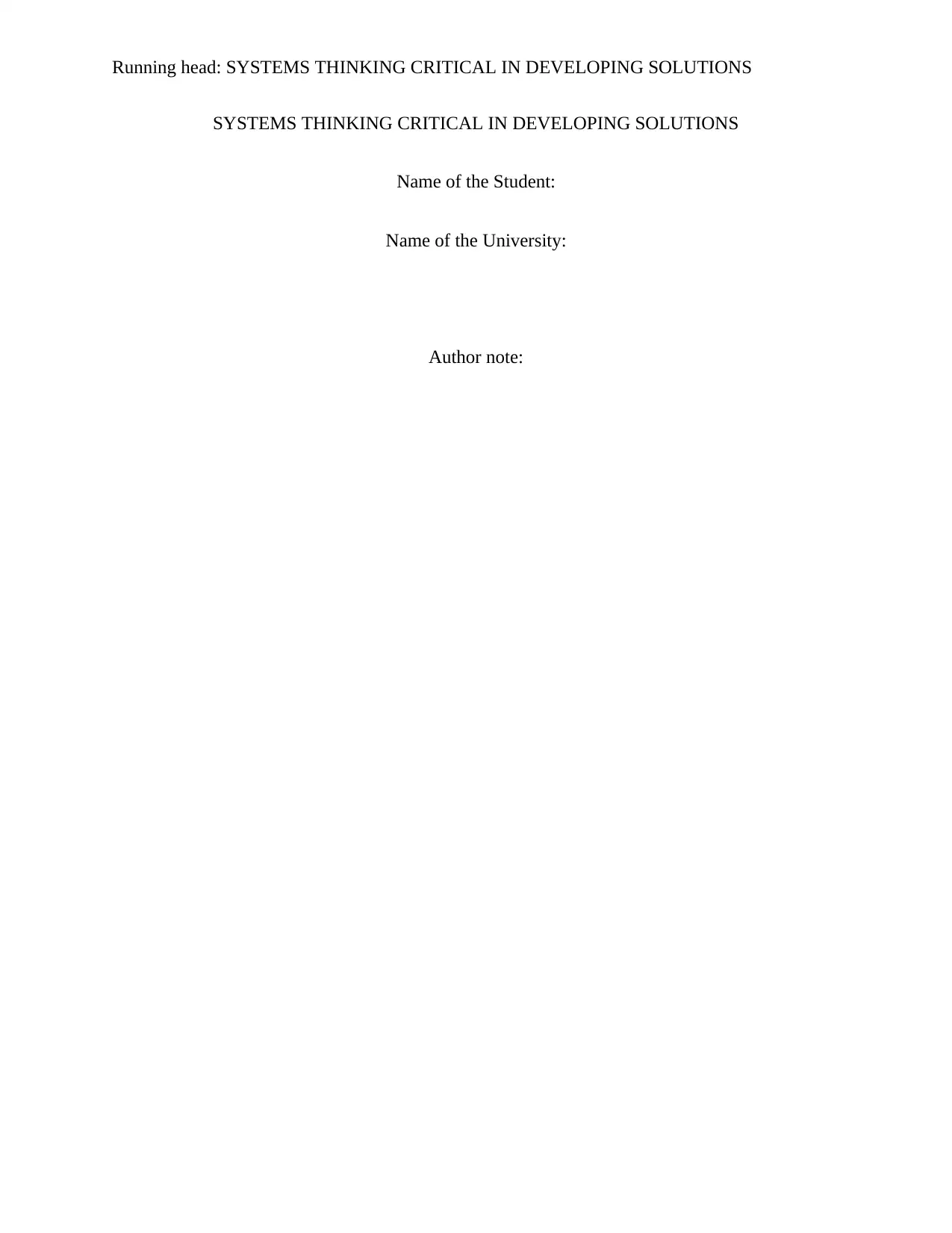
Running head: SYSTEMS THINKING CRITICAL IN DEVELOPING SOLUTIONS
SYSTEMS THINKING CRITICAL IN DEVELOPING SOLUTIONS
Name of the Student:
Name of the University:
Author note:
SYSTEMS THINKING CRITICAL IN DEVELOPING SOLUTIONS
Name of the Student:
Name of the University:
Author note:
Paraphrase This Document
Need a fresh take? Get an instant paraphrase of this document with our AI Paraphraser
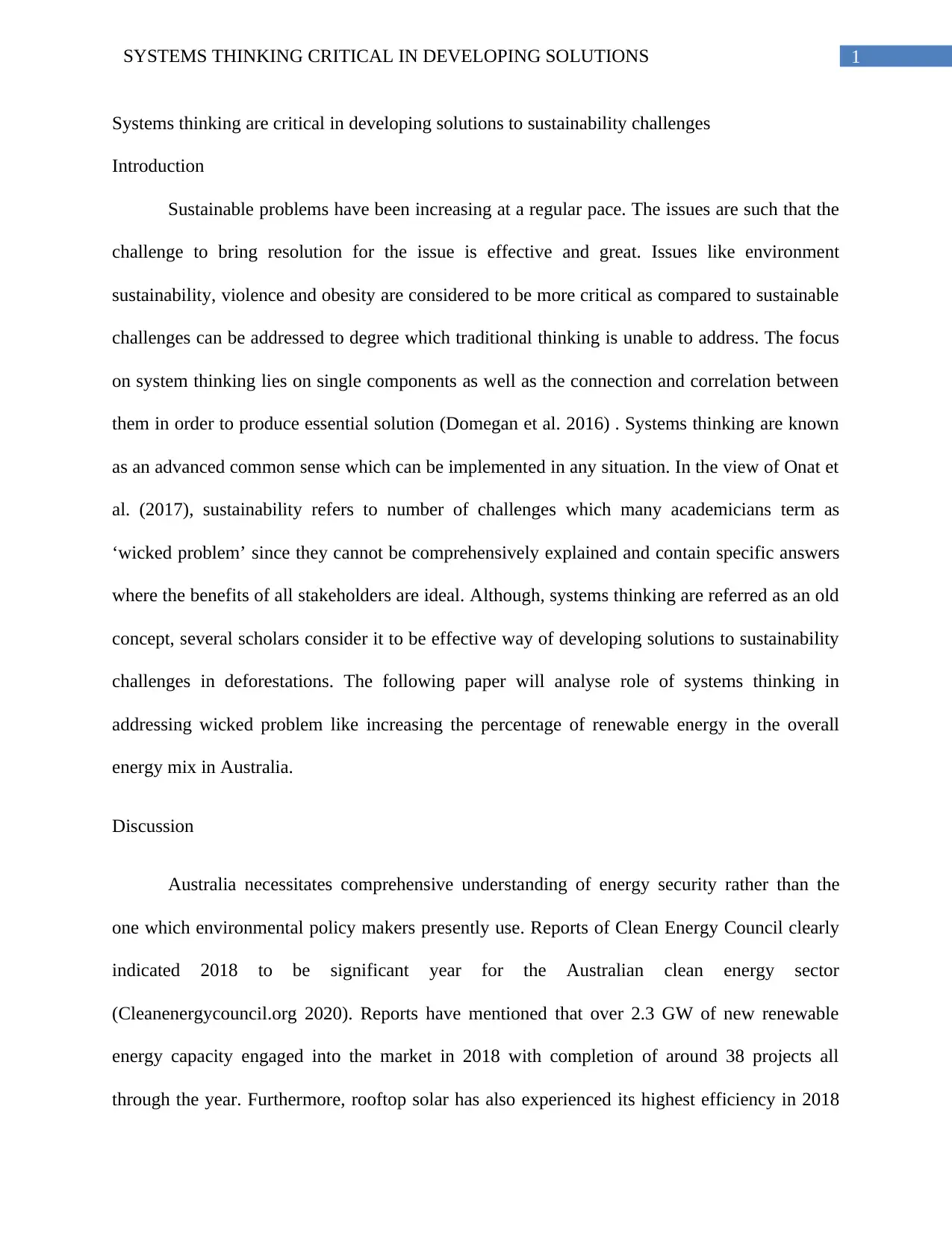
1SYSTEMS THINKING CRITICAL IN DEVELOPING SOLUTIONS
Systems thinking are critical in developing solutions to sustainability challenges
Introduction
Sustainable problems have been increasing at a regular pace. The issues are such that the
challenge to bring resolution for the issue is effective and great. Issues like environment
sustainability, violence and obesity are considered to be more critical as compared to sustainable
challenges can be addressed to degree which traditional thinking is unable to address. The focus
on system thinking lies on single components as well as the connection and correlation between
them in order to produce essential solution (Domegan et al. 2016) . Systems thinking are known
as an advanced common sense which can be implemented in any situation. In the view of Onat et
al. (2017), sustainability refers to number of challenges which many academicians term as
‘wicked problem’ since they cannot be comprehensively explained and contain specific answers
where the benefits of all stakeholders are ideal. Although, systems thinking are referred as an old
concept, several scholars consider it to be effective way of developing solutions to sustainability
challenges in deforestations. The following paper will analyse role of systems thinking in
addressing wicked problem like increasing the percentage of renewable energy in the overall
energy mix in Australia.
Discussion
Australia necessitates comprehensive understanding of energy security rather than the
one which environmental policy makers presently use. Reports of Clean Energy Council clearly
indicated 2018 to be significant year for the Australian clean energy sector
(Cleanenergycouncil.org 2020). Reports have mentioned that over 2.3 GW of new renewable
energy capacity engaged into the market in 2018 with completion of around 38 projects all
through the year. Furthermore, rooftop solar has also experienced its highest efficiency in 2018
Systems thinking are critical in developing solutions to sustainability challenges
Introduction
Sustainable problems have been increasing at a regular pace. The issues are such that the
challenge to bring resolution for the issue is effective and great. Issues like environment
sustainability, violence and obesity are considered to be more critical as compared to sustainable
challenges can be addressed to degree which traditional thinking is unable to address. The focus
on system thinking lies on single components as well as the connection and correlation between
them in order to produce essential solution (Domegan et al. 2016) . Systems thinking are known
as an advanced common sense which can be implemented in any situation. In the view of Onat et
al. (2017), sustainability refers to number of challenges which many academicians term as
‘wicked problem’ since they cannot be comprehensively explained and contain specific answers
where the benefits of all stakeholders are ideal. Although, systems thinking are referred as an old
concept, several scholars consider it to be effective way of developing solutions to sustainability
challenges in deforestations. The following paper will analyse role of systems thinking in
addressing wicked problem like increasing the percentage of renewable energy in the overall
energy mix in Australia.
Discussion
Australia necessitates comprehensive understanding of energy security rather than the
one which environmental policy makers presently use. Reports of Clean Energy Council clearly
indicated 2018 to be significant year for the Australian clean energy sector
(Cleanenergycouncil.org 2020). Reports have mentioned that over 2.3 GW of new renewable
energy capacity engaged into the market in 2018 with completion of around 38 projects all
through the year. Furthermore, rooftop solar has also experienced its highest efficiency in 2018
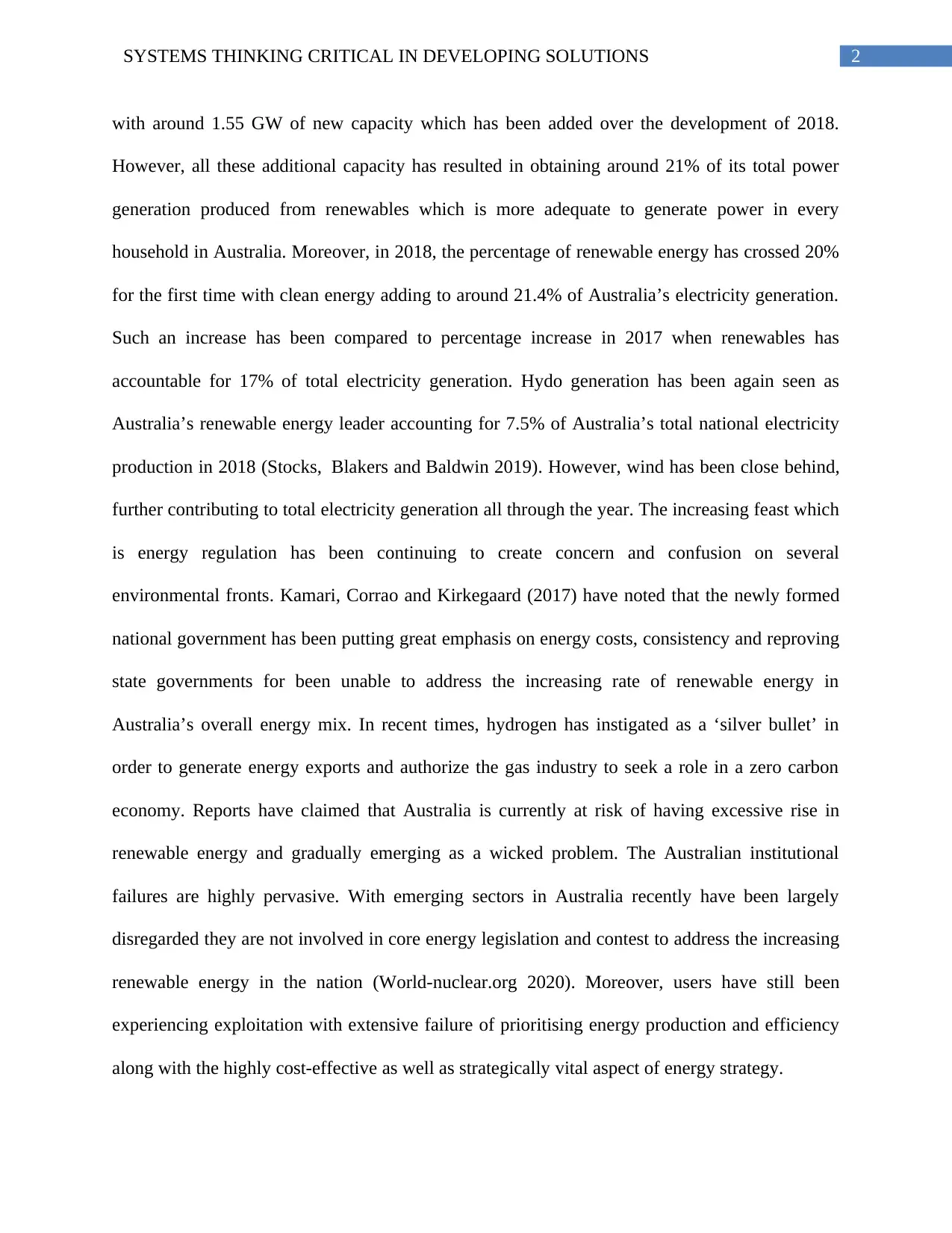
2SYSTEMS THINKING CRITICAL IN DEVELOPING SOLUTIONS
with around 1.55 GW of new capacity which has been added over the development of 2018.
However, all these additional capacity has resulted in obtaining around 21% of its total power
generation produced from renewables which is more adequate to generate power in every
household in Australia. Moreover, in 2018, the percentage of renewable energy has crossed 20%
for the first time with clean energy adding to around 21.4% of Australia’s electricity generation.
Such an increase has been compared to percentage increase in 2017 when renewables has
accountable for 17% of total electricity generation. Hydo generation has been again seen as
Australia’s renewable energy leader accounting for 7.5% of Australia’s total national electricity
production in 2018 (Stocks, Blakers and Baldwin 2019). However, wind has been close behind,
further contributing to total electricity generation all through the year. The increasing feast which
is energy regulation has been continuing to create concern and confusion on several
environmental fronts. Kamari, Corrao and Kirkegaard (2017) have noted that the newly formed
national government has been putting great emphasis on energy costs, consistency and reproving
state governments for been unable to address the increasing rate of renewable energy in
Australia’s overall energy mix. In recent times, hydrogen has instigated as a ‘silver bullet’ in
order to generate energy exports and authorize the gas industry to seek a role in a zero carbon
economy. Reports have claimed that Australia is currently at risk of having excessive rise in
renewable energy and gradually emerging as a wicked problem. The Australian institutional
failures are highly pervasive. With emerging sectors in Australia recently have been largely
disregarded they are not involved in core energy legislation and contest to address the increasing
renewable energy in the nation (World-nuclear.org 2020). Moreover, users have still been
experiencing exploitation with extensive failure of prioritising energy production and efficiency
along with the highly cost-effective as well as strategically vital aspect of energy strategy.
with around 1.55 GW of new capacity which has been added over the development of 2018.
However, all these additional capacity has resulted in obtaining around 21% of its total power
generation produced from renewables which is more adequate to generate power in every
household in Australia. Moreover, in 2018, the percentage of renewable energy has crossed 20%
for the first time with clean energy adding to around 21.4% of Australia’s electricity generation.
Such an increase has been compared to percentage increase in 2017 when renewables has
accountable for 17% of total electricity generation. Hydo generation has been again seen as
Australia’s renewable energy leader accounting for 7.5% of Australia’s total national electricity
production in 2018 (Stocks, Blakers and Baldwin 2019). However, wind has been close behind,
further contributing to total electricity generation all through the year. The increasing feast which
is energy regulation has been continuing to create concern and confusion on several
environmental fronts. Kamari, Corrao and Kirkegaard (2017) have noted that the newly formed
national government has been putting great emphasis on energy costs, consistency and reproving
state governments for been unable to address the increasing rate of renewable energy in
Australia’s overall energy mix. In recent times, hydrogen has instigated as a ‘silver bullet’ in
order to generate energy exports and authorize the gas industry to seek a role in a zero carbon
economy. Reports have claimed that Australia is currently at risk of having excessive rise in
renewable energy and gradually emerging as a wicked problem. The Australian institutional
failures are highly pervasive. With emerging sectors in Australia recently have been largely
disregarded they are not involved in core energy legislation and contest to address the increasing
renewable energy in the nation (World-nuclear.org 2020). Moreover, users have still been
experiencing exploitation with extensive failure of prioritising energy production and efficiency
along with the highly cost-effective as well as strategically vital aspect of energy strategy.
⊘ This is a preview!⊘
Do you want full access?
Subscribe today to unlock all pages.

Trusted by 1+ million students worldwide
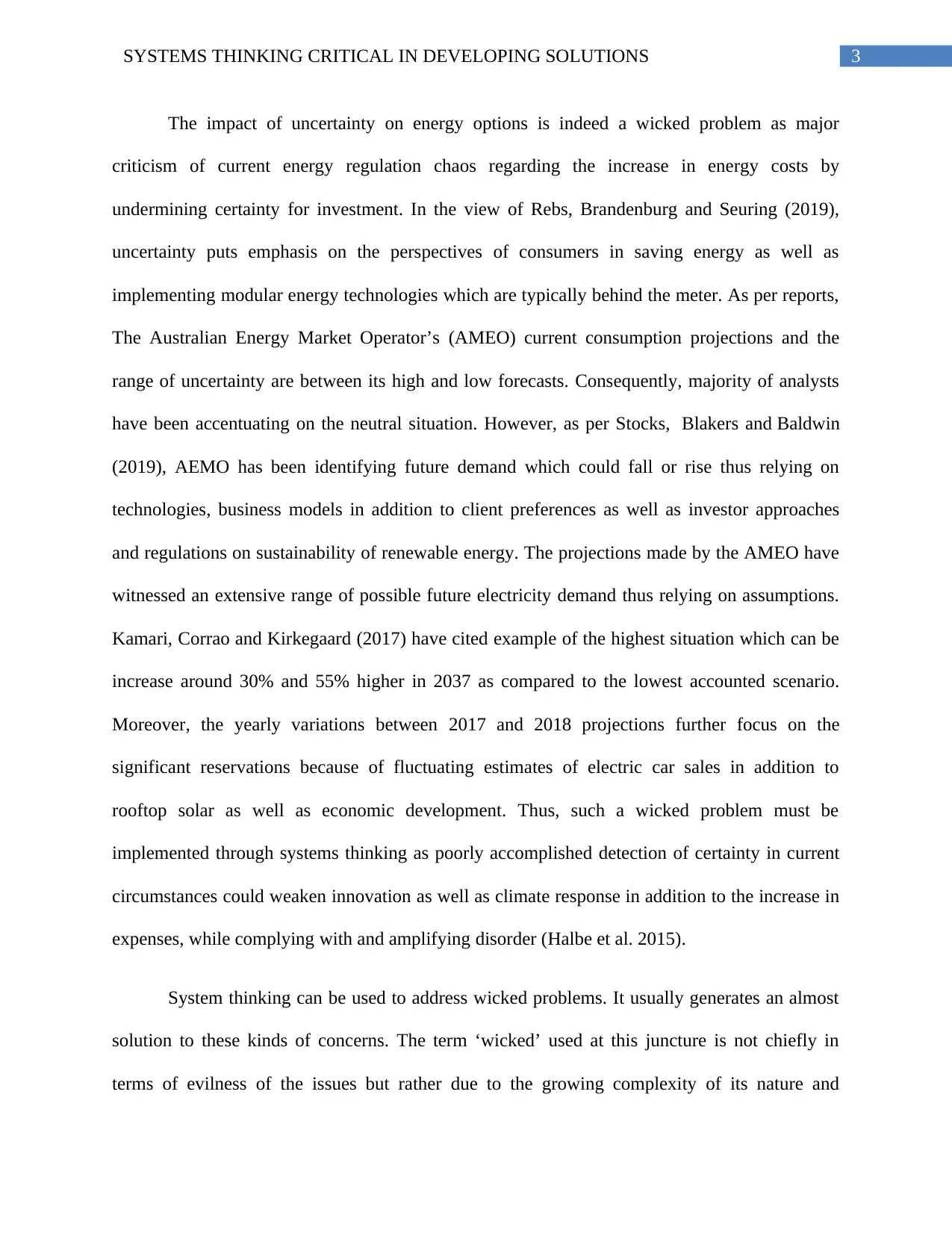
3SYSTEMS THINKING CRITICAL IN DEVELOPING SOLUTIONS
The impact of uncertainty on energy options is indeed a wicked problem as major
criticism of current energy regulation chaos regarding the increase in energy costs by
undermining certainty for investment. In the view of Rebs, Brandenburg and Seuring (2019),
uncertainty puts emphasis on the perspectives of consumers in saving energy as well as
implementing modular energy technologies which are typically behind the meter. As per reports,
The Australian Energy Market Operator’s (AMEO) current consumption projections and the
range of uncertainty are between its high and low forecasts. Consequently, majority of analysts
have been accentuating on the neutral situation. However, as per Stocks, Blakers and Baldwin
(2019), AEMO has been identifying future demand which could fall or rise thus relying on
technologies, business models in addition to client preferences as well as investor approaches
and regulations on sustainability of renewable energy. The projections made by the AMEO have
witnessed an extensive range of possible future electricity demand thus relying on assumptions.
Kamari, Corrao and Kirkegaard (2017) have cited example of the highest situation which can be
increase around 30% and 55% higher in 2037 as compared to the lowest accounted scenario.
Moreover, the yearly variations between 2017 and 2018 projections further focus on the
significant reservations because of fluctuating estimates of electric car sales in addition to
rooftop solar as well as economic development. Thus, such a wicked problem must be
implemented through systems thinking as poorly accomplished detection of certainty in current
circumstances could weaken innovation as well as climate response in addition to the increase in
expenses, while complying with and amplifying disorder (Halbe et al. 2015).
System thinking can be used to address wicked problems. It usually generates an almost
solution to these kinds of concerns. The term ‘wicked’ used at this juncture is not chiefly in
terms of evilness of the issues but rather due to the growing complexity of its nature and
The impact of uncertainty on energy options is indeed a wicked problem as major
criticism of current energy regulation chaos regarding the increase in energy costs by
undermining certainty for investment. In the view of Rebs, Brandenburg and Seuring (2019),
uncertainty puts emphasis on the perspectives of consumers in saving energy as well as
implementing modular energy technologies which are typically behind the meter. As per reports,
The Australian Energy Market Operator’s (AMEO) current consumption projections and the
range of uncertainty are between its high and low forecasts. Consequently, majority of analysts
have been accentuating on the neutral situation. However, as per Stocks, Blakers and Baldwin
(2019), AEMO has been identifying future demand which could fall or rise thus relying on
technologies, business models in addition to client preferences as well as investor approaches
and regulations on sustainability of renewable energy. The projections made by the AMEO have
witnessed an extensive range of possible future electricity demand thus relying on assumptions.
Kamari, Corrao and Kirkegaard (2017) have cited example of the highest situation which can be
increase around 30% and 55% higher in 2037 as compared to the lowest accounted scenario.
Moreover, the yearly variations between 2017 and 2018 projections further focus on the
significant reservations because of fluctuating estimates of electric car sales in addition to
rooftop solar as well as economic development. Thus, such a wicked problem must be
implemented through systems thinking as poorly accomplished detection of certainty in current
circumstances could weaken innovation as well as climate response in addition to the increase in
expenses, while complying with and amplifying disorder (Halbe et al. 2015).
System thinking can be used to address wicked problems. It usually generates an almost
solution to these kinds of concerns. The term ‘wicked’ used at this juncture is not chiefly in
terms of evilness of the issues but rather due to the growing complexity of its nature and
Paraphrase This Document
Need a fresh take? Get an instant paraphrase of this document with our AI Paraphraser
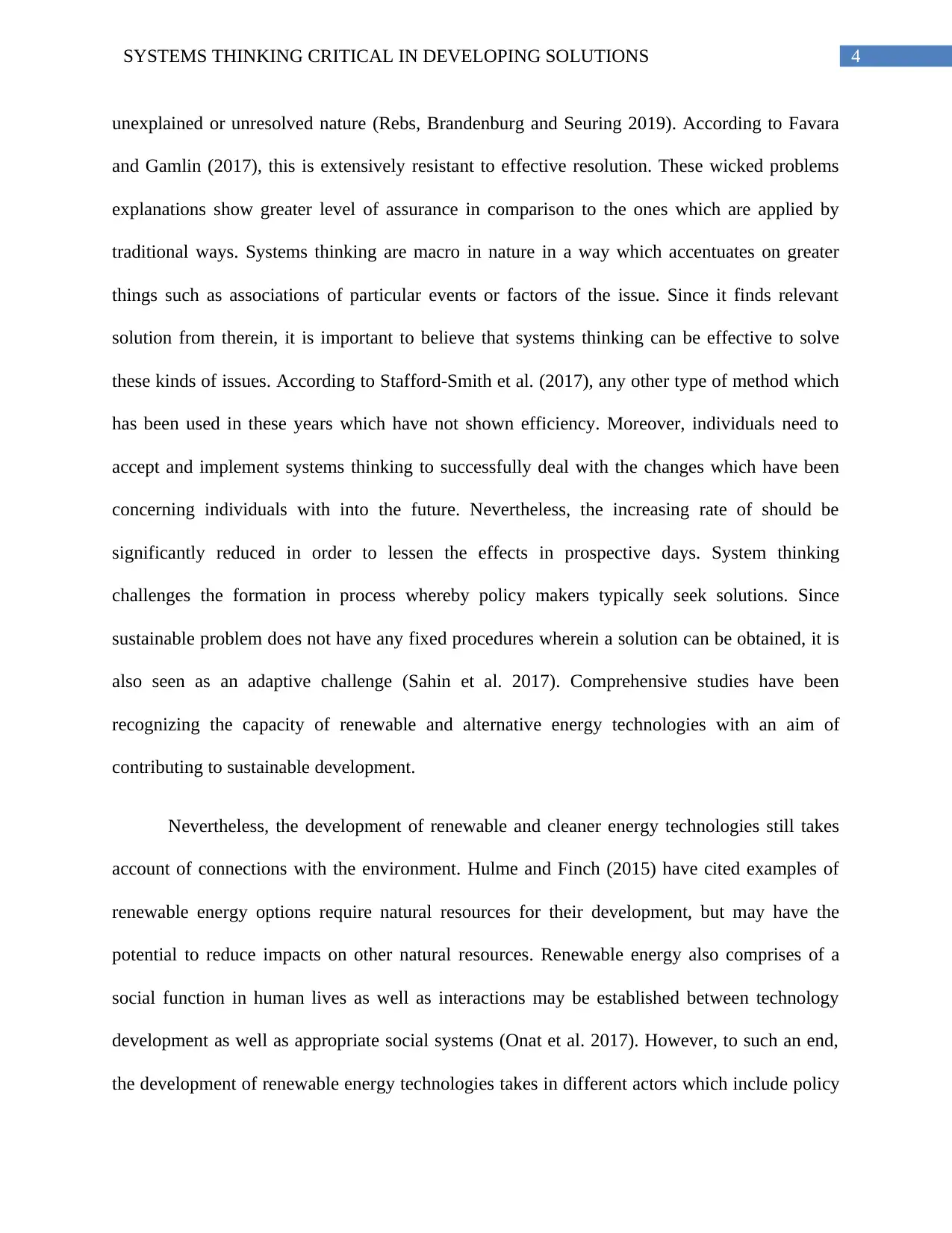
4SYSTEMS THINKING CRITICAL IN DEVELOPING SOLUTIONS
unexplained or unresolved nature (Rebs, Brandenburg and Seuring 2019). According to Favara
and Gamlin (2017), this is extensively resistant to effective resolution. These wicked problems
explanations show greater level of assurance in comparison to the ones which are applied by
traditional ways. Systems thinking are macro in nature in a way which accentuates on greater
things such as associations of particular events or factors of the issue. Since it finds relevant
solution from therein, it is important to believe that systems thinking can be effective to solve
these kinds of issues. According to Stafford-Smith et al. (2017), any other type of method which
has been used in these years which have not shown efficiency. Moreover, individuals need to
accept and implement systems thinking to successfully deal with the changes which have been
concerning individuals with into the future. Nevertheless, the increasing rate of should be
significantly reduced in order to lessen the effects in prospective days. System thinking
challenges the formation in process whereby policy makers typically seek solutions. Since
sustainable problem does not have any fixed procedures wherein a solution can be obtained, it is
also seen as an adaptive challenge (Sahin et al. 2017). Comprehensive studies have been
recognizing the capacity of renewable and alternative energy technologies with an aim of
contributing to sustainable development.
Nevertheless, the development of renewable and cleaner energy technologies still takes
account of connections with the environment. Hulme and Finch (2015) have cited examples of
renewable energy options require natural resources for their development, but may have the
potential to reduce impacts on other natural resources. Renewable energy also comprises of a
social function in human lives as well as interactions may be established between technology
development as well as appropriate social systems (Onat et al. 2017). However, to such an end,
the development of renewable energy technologies takes in different actors which include policy
unexplained or unresolved nature (Rebs, Brandenburg and Seuring 2019). According to Favara
and Gamlin (2017), this is extensively resistant to effective resolution. These wicked problems
explanations show greater level of assurance in comparison to the ones which are applied by
traditional ways. Systems thinking are macro in nature in a way which accentuates on greater
things such as associations of particular events or factors of the issue. Since it finds relevant
solution from therein, it is important to believe that systems thinking can be effective to solve
these kinds of issues. According to Stafford-Smith et al. (2017), any other type of method which
has been used in these years which have not shown efficiency. Moreover, individuals need to
accept and implement systems thinking to successfully deal with the changes which have been
concerning individuals with into the future. Nevertheless, the increasing rate of should be
significantly reduced in order to lessen the effects in prospective days. System thinking
challenges the formation in process whereby policy makers typically seek solutions. Since
sustainable problem does not have any fixed procedures wherein a solution can be obtained, it is
also seen as an adaptive challenge (Sahin et al. 2017). Comprehensive studies have been
recognizing the capacity of renewable and alternative energy technologies with an aim of
contributing to sustainable development.
Nevertheless, the development of renewable and cleaner energy technologies still takes
account of connections with the environment. Hulme and Finch (2015) have cited examples of
renewable energy options require natural resources for their development, but may have the
potential to reduce impacts on other natural resources. Renewable energy also comprises of a
social function in human lives as well as interactions may be established between technology
development as well as appropriate social systems (Onat et al. 2017). However, to such an end,
the development of renewable energy technologies takes in different actors which include policy
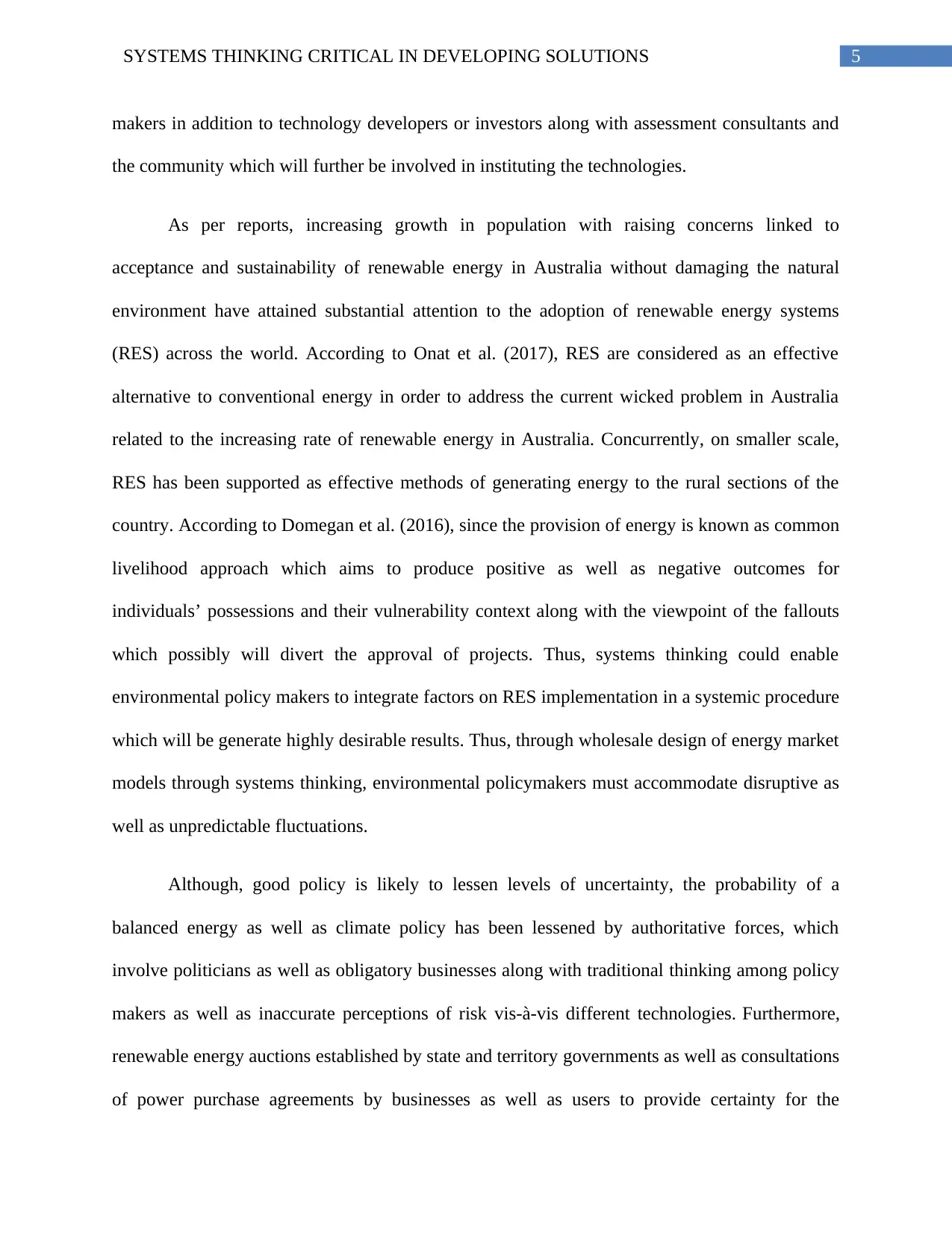
5SYSTEMS THINKING CRITICAL IN DEVELOPING SOLUTIONS
makers in addition to technology developers or investors along with assessment consultants and
the community which will further be involved in instituting the technologies.
As per reports, increasing growth in population with raising concerns linked to
acceptance and sustainability of renewable energy in Australia without damaging the natural
environment have attained substantial attention to the adoption of renewable energy systems
(RES) across the world. According to Onat et al. (2017), RES are considered as an effective
alternative to conventional energy in order to address the current wicked problem in Australia
related to the increasing rate of renewable energy in Australia. Concurrently, on smaller scale,
RES has been supported as effective methods of generating energy to the rural sections of the
country. According to Domegan et al. (2016), since the provision of energy is known as common
livelihood approach which aims to produce positive as well as negative outcomes for
individuals’ possessions and their vulnerability context along with the viewpoint of the fallouts
which possibly will divert the approval of projects. Thus, systems thinking could enable
environmental policy makers to integrate factors on RES implementation in a systemic procedure
which will be generate highly desirable results. Thus, through wholesale design of energy market
models through systems thinking, environmental policymakers must accommodate disruptive as
well as unpredictable fluctuations.
Although, good policy is likely to lessen levels of uncertainty, the probability of a
balanced energy as well as climate policy has been lessened by authoritative forces, which
involve politicians as well as obligatory businesses along with traditional thinking among policy
makers as well as inaccurate perceptions of risk vis-à-vis different technologies. Furthermore,
renewable energy auctions established by state and territory governments as well as consultations
of power purchase agreements by businesses as well as users to provide certainty for the
makers in addition to technology developers or investors along with assessment consultants and
the community which will further be involved in instituting the technologies.
As per reports, increasing growth in population with raising concerns linked to
acceptance and sustainability of renewable energy in Australia without damaging the natural
environment have attained substantial attention to the adoption of renewable energy systems
(RES) across the world. According to Onat et al. (2017), RES are considered as an effective
alternative to conventional energy in order to address the current wicked problem in Australia
related to the increasing rate of renewable energy in Australia. Concurrently, on smaller scale,
RES has been supported as effective methods of generating energy to the rural sections of the
country. According to Domegan et al. (2016), since the provision of energy is known as common
livelihood approach which aims to produce positive as well as negative outcomes for
individuals’ possessions and their vulnerability context along with the viewpoint of the fallouts
which possibly will divert the approval of projects. Thus, systems thinking could enable
environmental policy makers to integrate factors on RES implementation in a systemic procedure
which will be generate highly desirable results. Thus, through wholesale design of energy market
models through systems thinking, environmental policymakers must accommodate disruptive as
well as unpredictable fluctuations.
Although, good policy is likely to lessen levels of uncertainty, the probability of a
balanced energy as well as climate policy has been lessened by authoritative forces, which
involve politicians as well as obligatory businesses along with traditional thinking among policy
makers as well as inaccurate perceptions of risk vis-à-vis different technologies. Furthermore,
renewable energy auctions established by state and territory governments as well as consultations
of power purchase agreements by businesses as well as users to provide certainty for the
⊘ This is a preview!⊘
Do you want full access?
Subscribe today to unlock all pages.

Trusted by 1+ million students worldwide
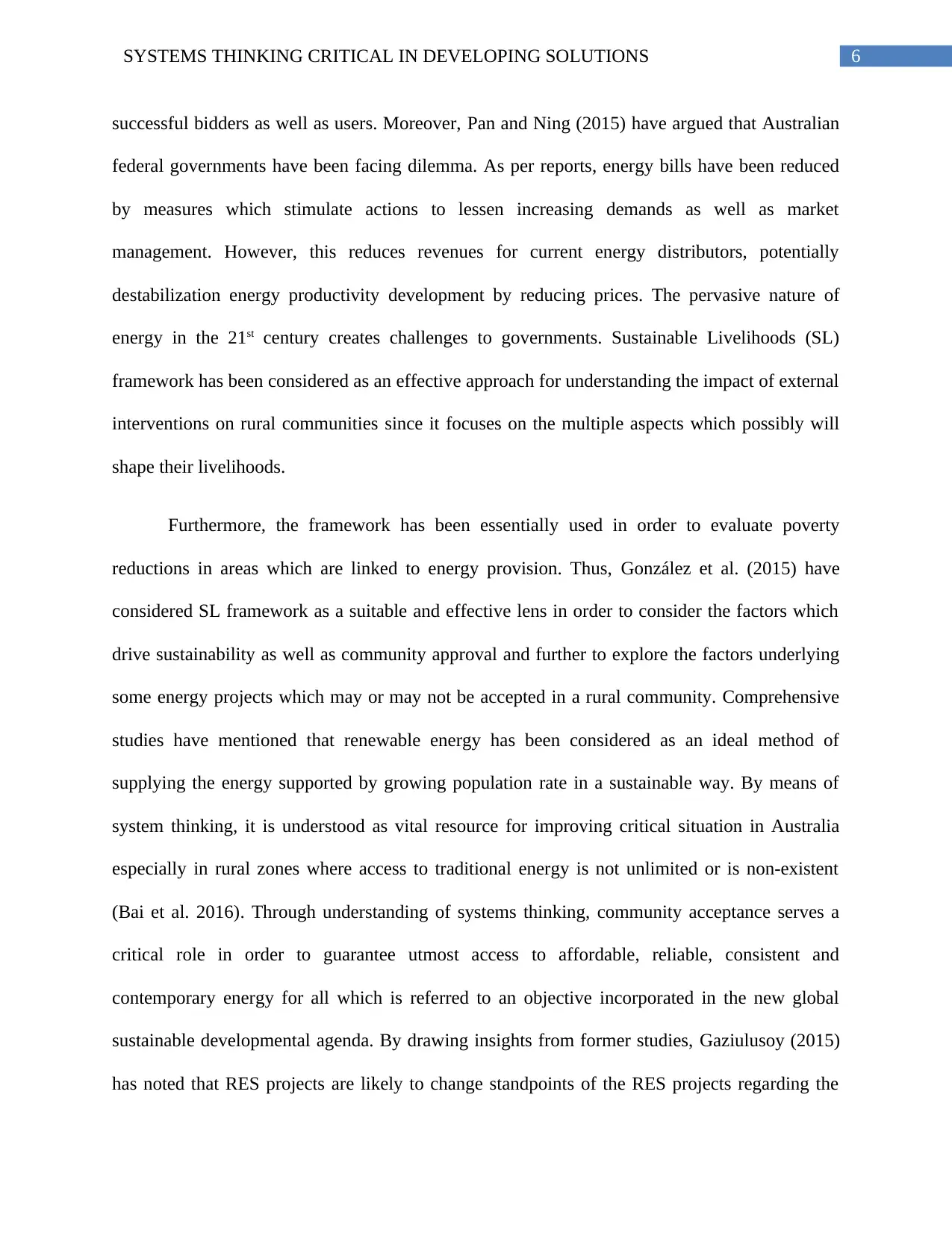
6SYSTEMS THINKING CRITICAL IN DEVELOPING SOLUTIONS
successful bidders as well as users. Moreover, Pan and Ning (2015) have argued that Australian
federal governments have been facing dilemma. As per reports, energy bills have been reduced
by measures which stimulate actions to lessen increasing demands as well as market
management. However, this reduces revenues for current energy distributors, potentially
destabilization energy productivity development by reducing prices. The pervasive nature of
energy in the 21st century creates challenges to governments. Sustainable Livelihoods (SL)
framework has been considered as an effective approach for understanding the impact of external
interventions on rural communities since it focuses on the multiple aspects which possibly will
shape their livelihoods.
Furthermore, the framework has been essentially used in order to evaluate poverty
reductions in areas which are linked to energy provision. Thus, González et al. (2015) have
considered SL framework as a suitable and effective lens in order to consider the factors which
drive sustainability as well as community approval and further to explore the factors underlying
some energy projects which may or may not be accepted in a rural community. Comprehensive
studies have mentioned that renewable energy has been considered as an ideal method of
supplying the energy supported by growing population rate in a sustainable way. By means of
system thinking, it is understood as vital resource for improving critical situation in Australia
especially in rural zones where access to traditional energy is not unlimited or is non-existent
(Bai et al. 2016). Through understanding of systems thinking, community acceptance serves a
critical role in order to guarantee utmost access to affordable, reliable, consistent and
contemporary energy for all which is referred to an objective incorporated in the new global
sustainable developmental agenda. By drawing insights from former studies, Gaziulusoy (2015)
has noted that RES projects are likely to change standpoints of the RES projects regarding the
successful bidders as well as users. Moreover, Pan and Ning (2015) have argued that Australian
federal governments have been facing dilemma. As per reports, energy bills have been reduced
by measures which stimulate actions to lessen increasing demands as well as market
management. However, this reduces revenues for current energy distributors, potentially
destabilization energy productivity development by reducing prices. The pervasive nature of
energy in the 21st century creates challenges to governments. Sustainable Livelihoods (SL)
framework has been considered as an effective approach for understanding the impact of external
interventions on rural communities since it focuses on the multiple aspects which possibly will
shape their livelihoods.
Furthermore, the framework has been essentially used in order to evaluate poverty
reductions in areas which are linked to energy provision. Thus, González et al. (2015) have
considered SL framework as a suitable and effective lens in order to consider the factors which
drive sustainability as well as community approval and further to explore the factors underlying
some energy projects which may or may not be accepted in a rural community. Comprehensive
studies have mentioned that renewable energy has been considered as an ideal method of
supplying the energy supported by growing population rate in a sustainable way. By means of
system thinking, it is understood as vital resource for improving critical situation in Australia
especially in rural zones where access to traditional energy is not unlimited or is non-existent
(Bai et al. 2016). Through understanding of systems thinking, community acceptance serves a
critical role in order to guarantee utmost access to affordable, reliable, consistent and
contemporary energy for all which is referred to an objective incorporated in the new global
sustainable developmental agenda. By drawing insights from former studies, Gaziulusoy (2015)
has noted that RES projects are likely to change standpoints of the RES projects regarding the
Paraphrase This Document
Need a fresh take? Get an instant paraphrase of this document with our AI Paraphraser
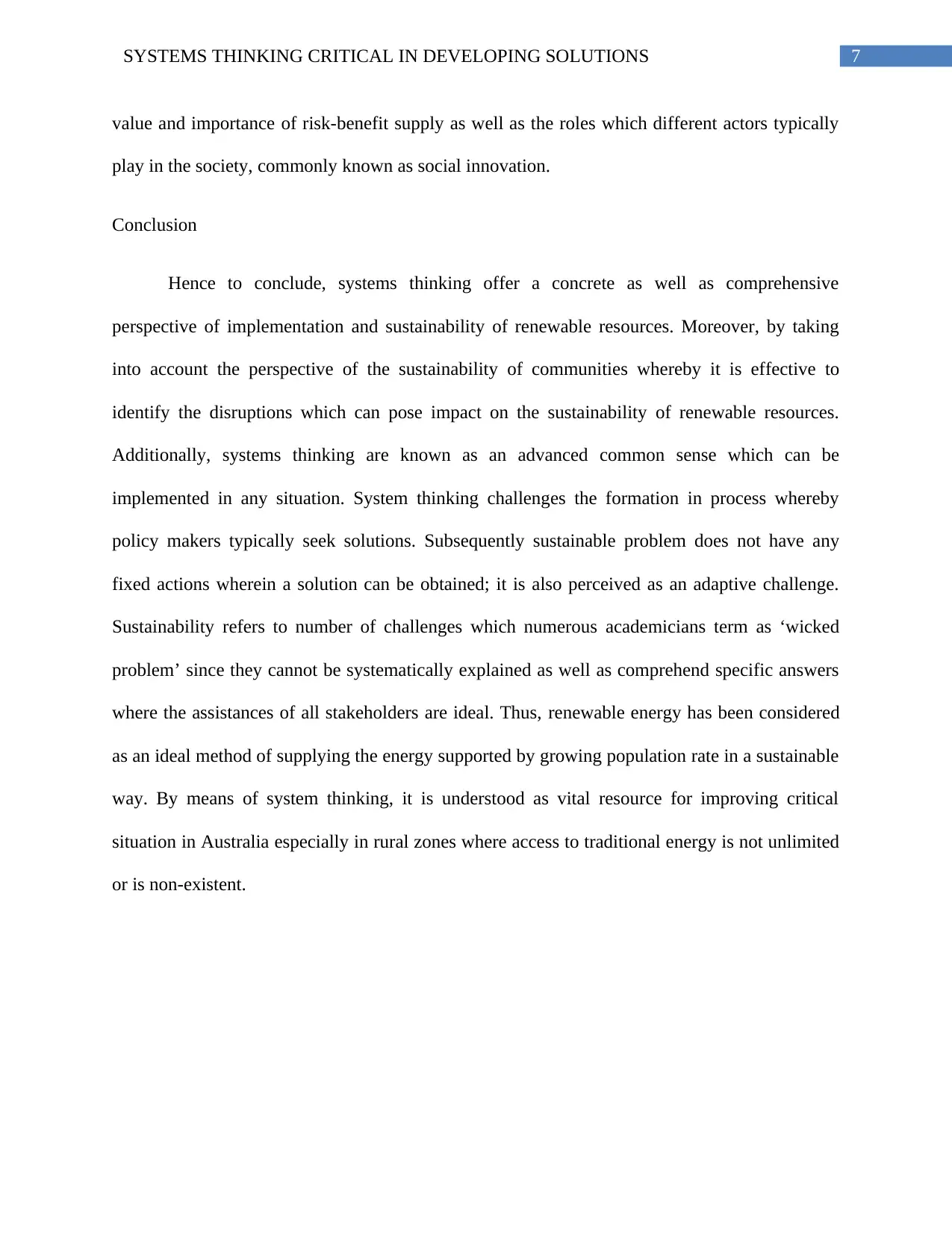
7SYSTEMS THINKING CRITICAL IN DEVELOPING SOLUTIONS
value and importance of risk-benefit supply as well as the roles which different actors typically
play in the society, commonly known as social innovation.
Conclusion
Hence to conclude, systems thinking offer a concrete as well as comprehensive
perspective of implementation and sustainability of renewable resources. Moreover, by taking
into account the perspective of the sustainability of communities whereby it is effective to
identify the disruptions which can pose impact on the sustainability of renewable resources.
Additionally, systems thinking are known as an advanced common sense which can be
implemented in any situation. System thinking challenges the formation in process whereby
policy makers typically seek solutions. Subsequently sustainable problem does not have any
fixed actions wherein a solution can be obtained; it is also perceived as an adaptive challenge.
Sustainability refers to number of challenges which numerous academicians term as ‘wicked
problem’ since they cannot be systematically explained as well as comprehend specific answers
where the assistances of all stakeholders are ideal. Thus, renewable energy has been considered
as an ideal method of supplying the energy supported by growing population rate in a sustainable
way. By means of system thinking, it is understood as vital resource for improving critical
situation in Australia especially in rural zones where access to traditional energy is not unlimited
or is non-existent.
value and importance of risk-benefit supply as well as the roles which different actors typically
play in the society, commonly known as social innovation.
Conclusion
Hence to conclude, systems thinking offer a concrete as well as comprehensive
perspective of implementation and sustainability of renewable resources. Moreover, by taking
into account the perspective of the sustainability of communities whereby it is effective to
identify the disruptions which can pose impact on the sustainability of renewable resources.
Additionally, systems thinking are known as an advanced common sense which can be
implemented in any situation. System thinking challenges the formation in process whereby
policy makers typically seek solutions. Subsequently sustainable problem does not have any
fixed actions wherein a solution can be obtained; it is also perceived as an adaptive challenge.
Sustainability refers to number of challenges which numerous academicians term as ‘wicked
problem’ since they cannot be systematically explained as well as comprehend specific answers
where the assistances of all stakeholders are ideal. Thus, renewable energy has been considered
as an ideal method of supplying the energy supported by growing population rate in a sustainable
way. By means of system thinking, it is understood as vital resource for improving critical
situation in Australia especially in rural zones where access to traditional energy is not unlimited
or is non-existent.
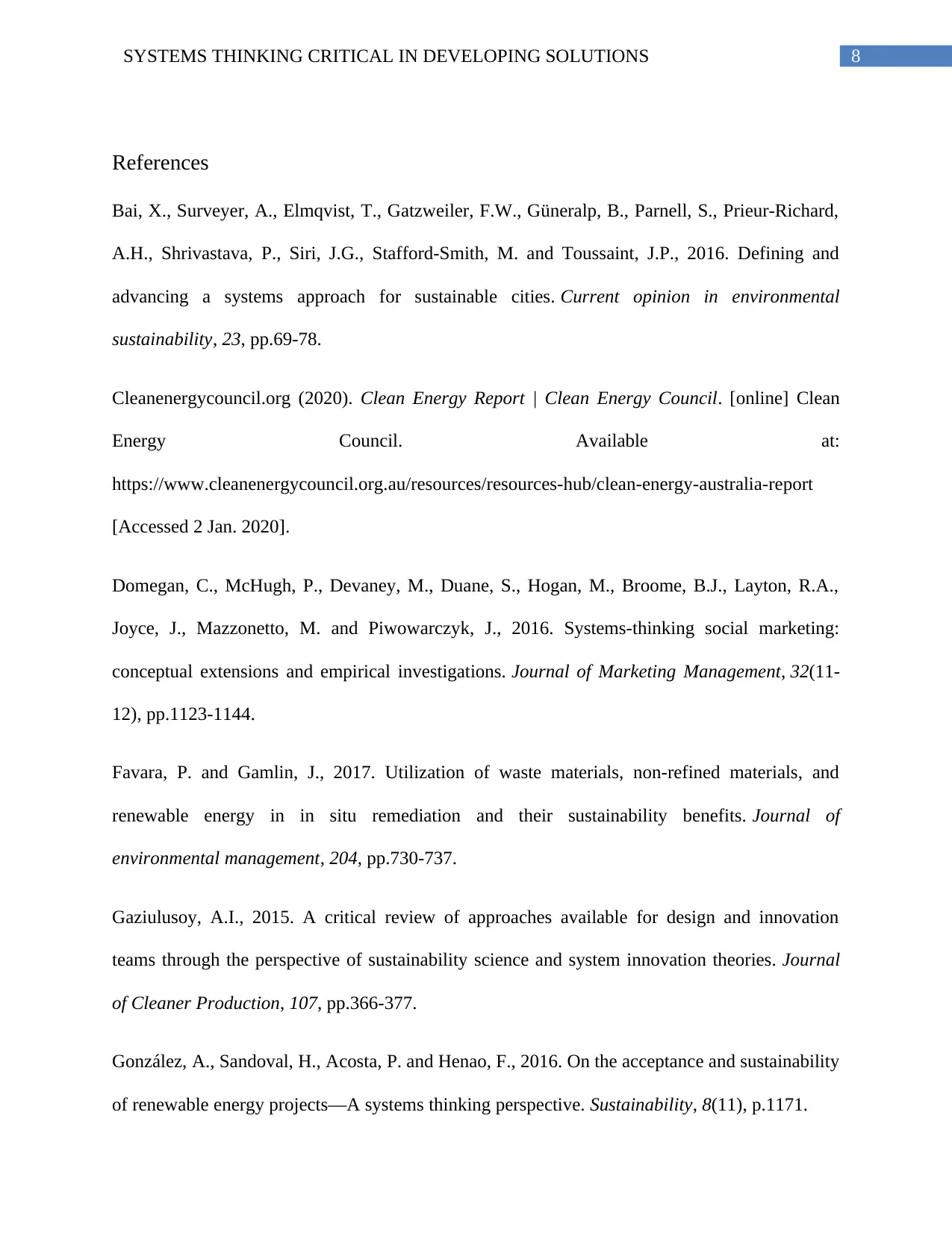
8SYSTEMS THINKING CRITICAL IN DEVELOPING SOLUTIONS
References
Bai, X., Surveyer, A., Elmqvist, T., Gatzweiler, F.W., Güneralp, B., Parnell, S., Prieur-Richard,
A.H., Shrivastava, P., Siri, J.G., Stafford-Smith, M. and Toussaint, J.P., 2016. Defining and
advancing a systems approach for sustainable cities. Current opinion in environmental
sustainability, 23, pp.69-78.
Cleanenergycouncil.org (2020). Clean Energy Report | Clean Energy Council. [online] Clean
Energy Council. Available at:
https://www.cleanenergycouncil.org.au/resources/resources-hub/clean-energy-australia-report
[Accessed 2 Jan. 2020].
Domegan, C., McHugh, P., Devaney, M., Duane, S., Hogan, M., Broome, B.J., Layton, R.A.,
Joyce, J., Mazzonetto, M. and Piwowarczyk, J., 2016. Systems-thinking social marketing:
conceptual extensions and empirical investigations. Journal of Marketing Management, 32(11-
12), pp.1123-1144.
Favara, P. and Gamlin, J., 2017. Utilization of waste materials, non-refined materials, and
renewable energy in in situ remediation and their sustainability benefits. Journal of
environmental management, 204, pp.730-737.
Gaziulusoy, A.I., 2015. A critical review of approaches available for design and innovation
teams through the perspective of sustainability science and system innovation theories. Journal
of Cleaner Production, 107, pp.366-377.
González, A., Sandoval, H., Acosta, P. and Henao, F., 2016. On the acceptance and sustainability
of renewable energy projects—A systems thinking perspective. Sustainability, 8(11), p.1171.
References
Bai, X., Surveyer, A., Elmqvist, T., Gatzweiler, F.W., Güneralp, B., Parnell, S., Prieur-Richard,
A.H., Shrivastava, P., Siri, J.G., Stafford-Smith, M. and Toussaint, J.P., 2016. Defining and
advancing a systems approach for sustainable cities. Current opinion in environmental
sustainability, 23, pp.69-78.
Cleanenergycouncil.org (2020). Clean Energy Report | Clean Energy Council. [online] Clean
Energy Council. Available at:
https://www.cleanenergycouncil.org.au/resources/resources-hub/clean-energy-australia-report
[Accessed 2 Jan. 2020].
Domegan, C., McHugh, P., Devaney, M., Duane, S., Hogan, M., Broome, B.J., Layton, R.A.,
Joyce, J., Mazzonetto, M. and Piwowarczyk, J., 2016. Systems-thinking social marketing:
conceptual extensions and empirical investigations. Journal of Marketing Management, 32(11-
12), pp.1123-1144.
Favara, P. and Gamlin, J., 2017. Utilization of waste materials, non-refined materials, and
renewable energy in in situ remediation and their sustainability benefits. Journal of
environmental management, 204, pp.730-737.
Gaziulusoy, A.I., 2015. A critical review of approaches available for design and innovation
teams through the perspective of sustainability science and system innovation theories. Journal
of Cleaner Production, 107, pp.366-377.
González, A., Sandoval, H., Acosta, P. and Henao, F., 2016. On the acceptance and sustainability
of renewable energy projects—A systems thinking perspective. Sustainability, 8(11), p.1171.
⊘ This is a preview!⊘
Do you want full access?
Subscribe today to unlock all pages.

Trusted by 1+ million students worldwide
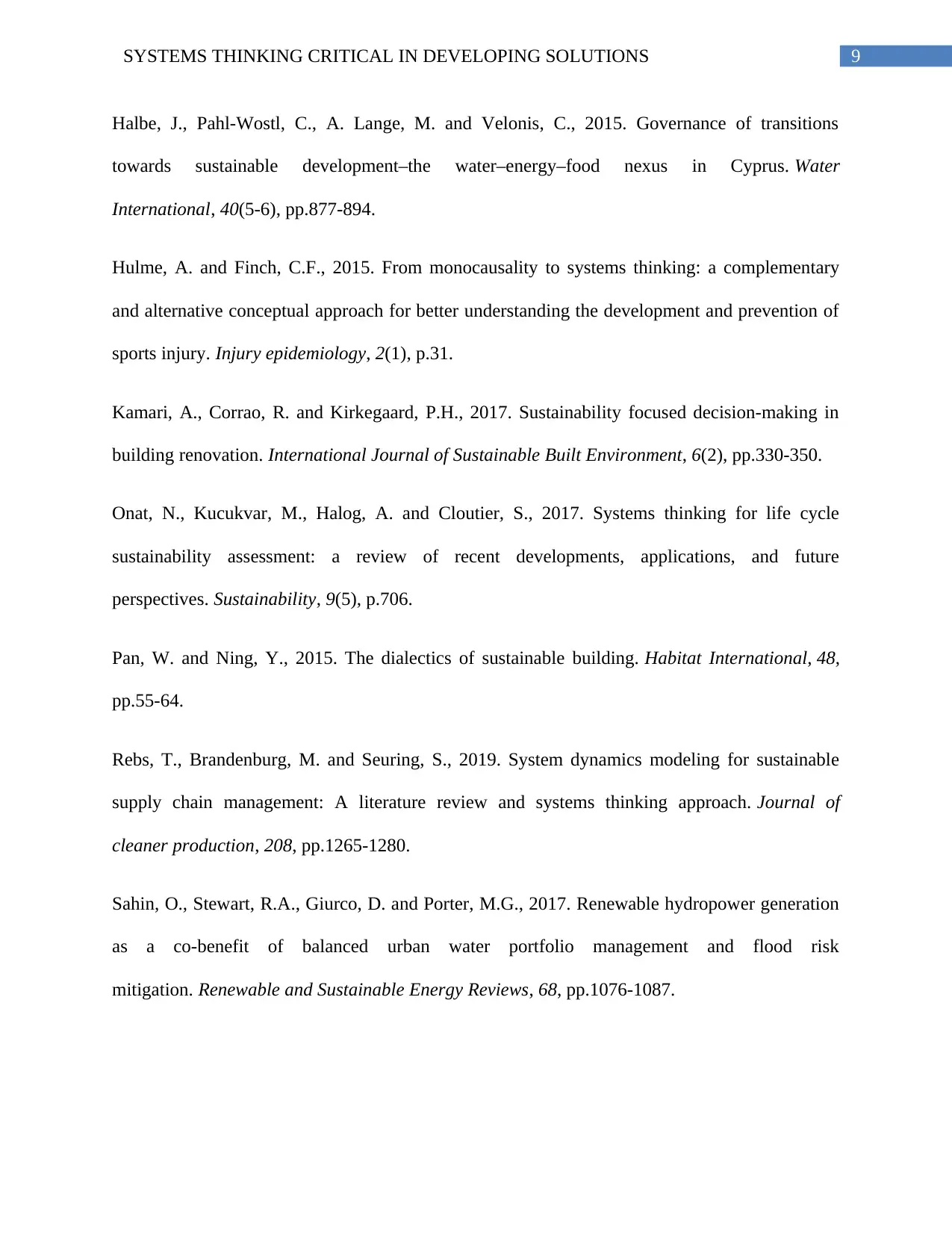
9SYSTEMS THINKING CRITICAL IN DEVELOPING SOLUTIONS
Halbe, J., Pahl-Wostl, C., A. Lange, M. and Velonis, C., 2015. Governance of transitions
towards sustainable development–the water–energy–food nexus in Cyprus. Water
International, 40(5-6), pp.877-894.
Hulme, A. and Finch, C.F., 2015. From monocausality to systems thinking: a complementary
and alternative conceptual approach for better understanding the development and prevention of
sports injury. Injury epidemiology, 2(1), p.31.
Kamari, A., Corrao, R. and Kirkegaard, P.H., 2017. Sustainability focused decision-making in
building renovation. International Journal of Sustainable Built Environment, 6(2), pp.330-350.
Onat, N., Kucukvar, M., Halog, A. and Cloutier, S., 2017. Systems thinking for life cycle
sustainability assessment: a review of recent developments, applications, and future
perspectives. Sustainability, 9(5), p.706.
Pan, W. and Ning, Y., 2015. The dialectics of sustainable building. Habitat International, 48,
pp.55-64.
Rebs, T., Brandenburg, M. and Seuring, S., 2019. System dynamics modeling for sustainable
supply chain management: A literature review and systems thinking approach. Journal of
cleaner production, 208, pp.1265-1280.
Sahin, O., Stewart, R.A., Giurco, D. and Porter, M.G., 2017. Renewable hydropower generation
as a co-benefit of balanced urban water portfolio management and flood risk
mitigation. Renewable and Sustainable Energy Reviews, 68, pp.1076-1087.
Halbe, J., Pahl-Wostl, C., A. Lange, M. and Velonis, C., 2015. Governance of transitions
towards sustainable development–the water–energy–food nexus in Cyprus. Water
International, 40(5-6), pp.877-894.
Hulme, A. and Finch, C.F., 2015. From monocausality to systems thinking: a complementary
and alternative conceptual approach for better understanding the development and prevention of
sports injury. Injury epidemiology, 2(1), p.31.
Kamari, A., Corrao, R. and Kirkegaard, P.H., 2017. Sustainability focused decision-making in
building renovation. International Journal of Sustainable Built Environment, 6(2), pp.330-350.
Onat, N., Kucukvar, M., Halog, A. and Cloutier, S., 2017. Systems thinking for life cycle
sustainability assessment: a review of recent developments, applications, and future
perspectives. Sustainability, 9(5), p.706.
Pan, W. and Ning, Y., 2015. The dialectics of sustainable building. Habitat International, 48,
pp.55-64.
Rebs, T., Brandenburg, M. and Seuring, S., 2019. System dynamics modeling for sustainable
supply chain management: A literature review and systems thinking approach. Journal of
cleaner production, 208, pp.1265-1280.
Sahin, O., Stewart, R.A., Giurco, D. and Porter, M.G., 2017. Renewable hydropower generation
as a co-benefit of balanced urban water portfolio management and flood risk
mitigation. Renewable and Sustainable Energy Reviews, 68, pp.1076-1087.
Paraphrase This Document
Need a fresh take? Get an instant paraphrase of this document with our AI Paraphraser
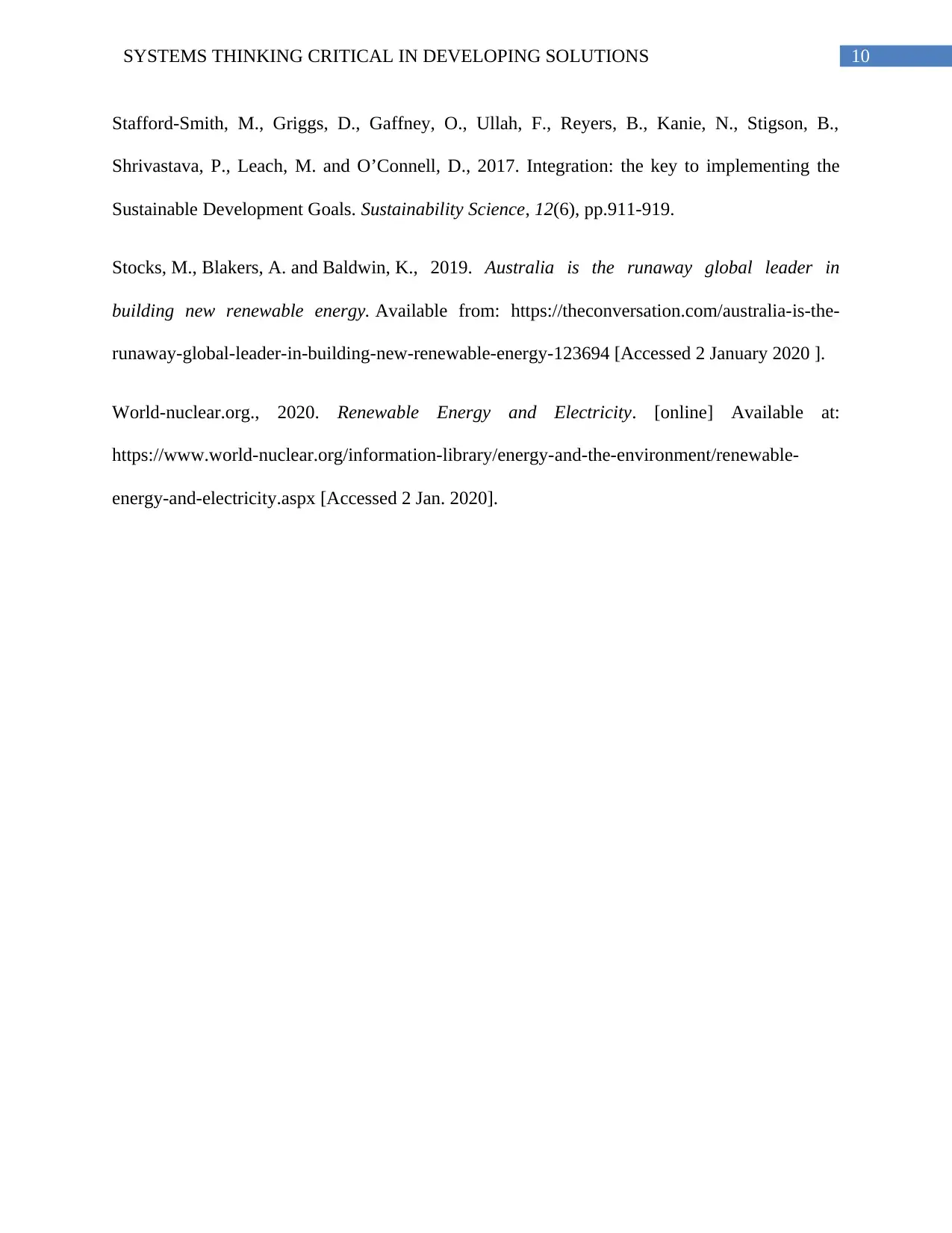
10SYSTEMS THINKING CRITICAL IN DEVELOPING SOLUTIONS
Stafford-Smith, M., Griggs, D., Gaffney, O., Ullah, F., Reyers, B., Kanie, N., Stigson, B.,
Shrivastava, P., Leach, M. and O’Connell, D., 2017. Integration: the key to implementing the
Sustainable Development Goals. Sustainability Science, 12(6), pp.911-919.
Stocks, M., Blakers, A. and Baldwin, K., 2019. Australia is the runaway global leader in
building new renewable energy. Available from: https://theconversation.com/australia-is-the-
runaway-global-leader-in-building-new-renewable-energy-123694 [Accessed 2 January 2020 ].
World-nuclear.org., 2020. Renewable Energy and Electricity. [online] Available at:
https://www.world-nuclear.org/information-library/energy-and-the-environment/renewable-
energy-and-electricity.aspx [Accessed 2 Jan. 2020].
Stafford-Smith, M., Griggs, D., Gaffney, O., Ullah, F., Reyers, B., Kanie, N., Stigson, B.,
Shrivastava, P., Leach, M. and O’Connell, D., 2017. Integration: the key to implementing the
Sustainable Development Goals. Sustainability Science, 12(6), pp.911-919.
Stocks, M., Blakers, A. and Baldwin, K., 2019. Australia is the runaway global leader in
building new renewable energy. Available from: https://theconversation.com/australia-is-the-
runaway-global-leader-in-building-new-renewable-energy-123694 [Accessed 2 January 2020 ].
World-nuclear.org., 2020. Renewable Energy and Electricity. [online] Available at:
https://www.world-nuclear.org/information-library/energy-and-the-environment/renewable-
energy-and-electricity.aspx [Accessed 2 Jan. 2020].
1 out of 11
Related Documents
Your All-in-One AI-Powered Toolkit for Academic Success.
+13062052269
info@desklib.com
Available 24*7 on WhatsApp / Email
![[object Object]](/_next/static/media/star-bottom.7253800d.svg)
Unlock your academic potential
Copyright © 2020–2025 A2Z Services. All Rights Reserved. Developed and managed by ZUCOL.





